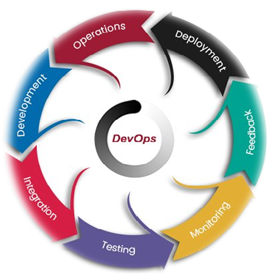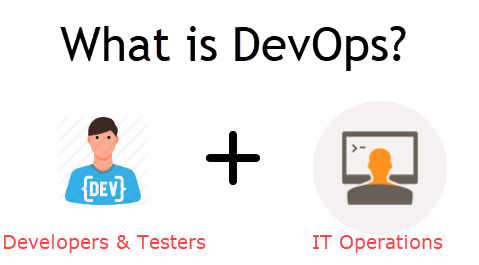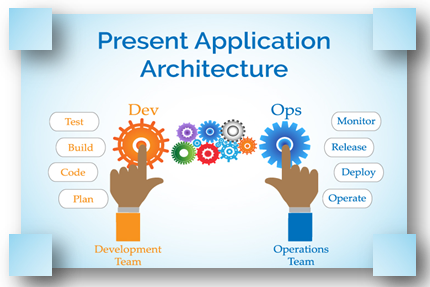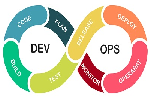
DevOps is Development and Operation's Collaboration; itís a Combination of Process, People and Working Product that enable continuous integration and continuous delivery of importance to our end users. DevOps speed up the process to distribute applications and software services at extraordinary quickness and high speed. The DevOps seminar will help you to learn DevOps from scracth to deep knowledge of various DevOps tools such as and Kubernetes.The DevOps is a combination of 2 words, one is Software Development, and second is Operations. DevOps allows a single team to manage the complete application, from Software Development to Testing the Product and Deployment, and Operations. DevOps helps you to reduce the interruptions between software developers, quality assurance (QA) engineer teams, and system administrators. 
DevOps encourages collaboration between Development and Operation teams to deploy product to production more rapidly in an automated and repeatable DevOps supports to increase speed to deliver end user applications and application services. It similarly allows organizations to help their customers better and participate more powerfully in the marketplace. DevOps can also be defined as a sequence of development and IT activities with better communication and collaboration. DevOps has become one of the most valuable trade units for firms or organizations. With the benefit of DevOps, the excellence and rapidity of application delivery have greatly improved DevOps is nothing more than a method or method by which "developers" and "operations" work together. DevOps represents a shift in IT culture with a full focus on accelerated IT service delivery by adopting agile practices in the face of a system-based approach DevOps is about the process of integration and development of operations. Companies that have adopted DevOps have seen a 27% improvement in software quality and a 25% improvement in application frequency frequency and a 40% increase in customer satisfaction. Successful DevOps implementation resulted in 30% revenue increase. 1. Littler development phases, faster modernisation When we have a biased response from development and operations teams, it is difficult to tell whether the application is working or not. When development teams submit a request, cycle times can be unnecessarily extended. With combined improvement and operations efforts, the teamís applications are ready to be used more rapidly. This is important because companies succeed based on their ability to innovate faster than their challengers. Earlier going any more, we need to understand why we need DevOps over other procedures.
Here are some key features of DevOps architecture, such as: 
1. PlanDevOps use an agile methodology to plan growth. Unscheduled work always reduces productivity. Synchronizes with the development and operations team, which helps manage the workflow to create a plan that maximizes productivity. 2. CodeMany good practices, such as the widely used git, allow code to be used, which helps businesses not only write code, but also track changes, inform the reasons behind the change, and revert back to the original code if needed. The code can be set and reused in files and folders. 3. BuildWithout DevOps, the cost of resource utilization is estimated based on a predefined individual consumption with fixed hardware allocation. With DevOps, cloud utilization, resource sharing comes into the picture, and the build depends on the user's need, which is the mechanism for controlling resource usage or efficiency.. 4. TestThe application will travel to production after it is verified. In the situation of Manual Testing, it consumes additional time in testing and moving the code to production. Testing can be completed by automation, which reduces the time for testing, thereby reducing the time required to generate the code, because automating the running of scripts avoids many manual steps. 5. OperateDevOps replaces the traditional approach of developing and testing separately. Teams work in partnership with both teams actively participating in the service lifecycle. The operations team interacts with the developers and they come up with a monitoring plan for IT and business needs. 6. DeployMost systems can support the scheduler for automatic deployment. The Cloud Management Platform enables users to capture accurate insights and analyze trends on the trends through the deployment of dashboards. 7. ReleaseGenerally, deployment to the environment can be done through automation. But when the product is deployed to the environment, it is done by manual triggering. Most processes involved in release management usually require that the product be deployed manually in the production environment to minimize impact on customers. 8. MonitorContinuous monitoring is used to detect any risks of failure. It also helps to track the system accurately so that the health of the application can be checked as well. Monitoring the log data with a number of third party tools such as Splunk / Nagios is easy with monitoring services. Of course, there are benefits from cloud adoption, but there are also benefits of DevOps as a service: Collaborative ease: With the development tools in the cloud, it's easy to collaborate with customers anywhere. And as a key contribution to the DevOps philosophy, this is a huge benefit! Rapid testing and deployment: Generally, when companies use cloud services, it enables them to increase their release frequency. With more computing power and data storage, the cloud makes the process easier and faster. Improved Documentation and Quality Control: Using cloud services is more data-driven so everyone on the team can use the same dataset. This leads to better documentation and quality control. Associate with Internal DevOps: DevOps as a Service does not require you to have an internal DevOps deployment process. It makes it easy to offload different parts of the project for better collaboration and quick turnaround. It's built-in IT: Many leading cloud providers have created DevOps tools within their features that work towards continuous delivery, and leading DevOps tools work with these cloud providers to help you get the results you need.
|
Learn Latest Technologies

DevOps

AWS

Python

Azure

G Cloud

Linux

Web Tech

Data Bases

Testing

Git

Ansible

Chef

Kubernetes

HTML

CSS


